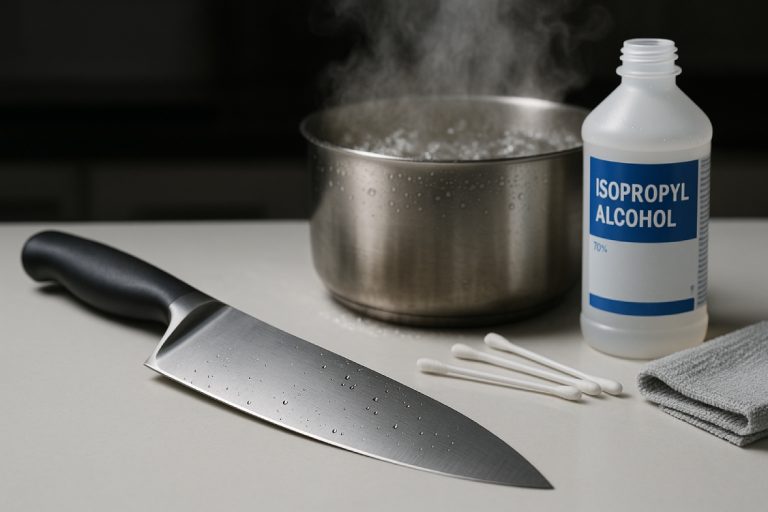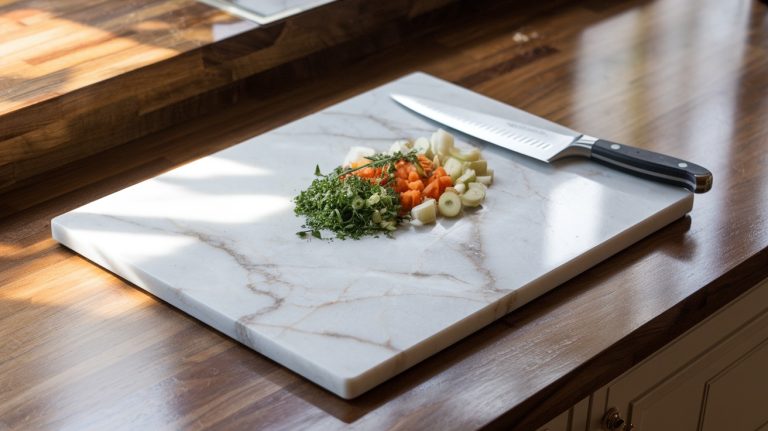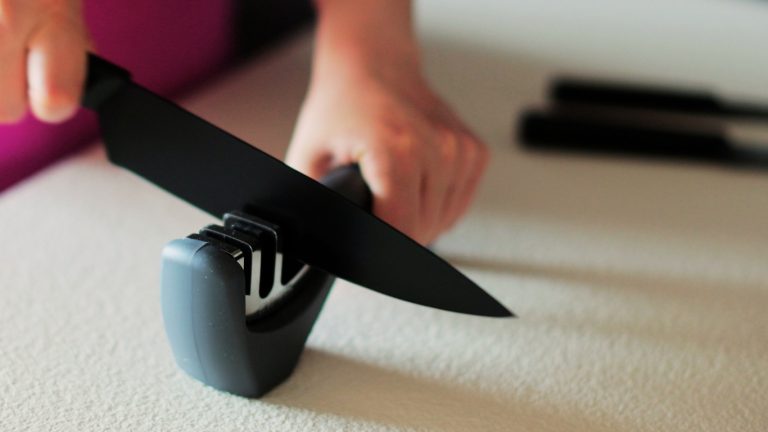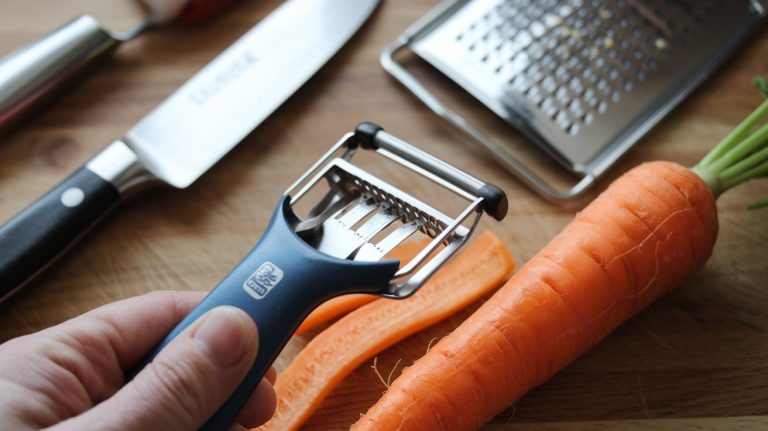How to Keep Knives From Rusting: Simple Care Tips That Work
To keep your knives from rusting, always clean them promptly with mild soap and warm water, especially after contact with acidic foods. Then dry them thoroughly; never air dry.
Store knives in dry, ventilated holders away from moisture. Apply a thin layer of food-grade oil regularly to create a moisture barrier, particularly on carbon steel blades, which benefit from a protective patina.
Address any rust spots immediately to prevent spread. Discover how specialized care and maintenance further extend their lifespan.
Key Takeaways
- Clean knives immediately after use with mild soap and warm water, especially after contact with acidic foods, then dry thoroughly with a cloth.
- Store knives in a dry, well-ventilated area using knife blocks or magnetic holders that prevent moisture buildup and abrasion.
- Apply a thin layer of food-grade mineral oil regularly to create a moisture barrier and protect blades from oxidation.
- Remove early rust signs promptly using baking soda paste or vinegar soak, then neutralize and dry to prevent further corrosion.
- Encourage patina formation on carbon steel knives to build a natural, self-renewing protective oxide layer that resists rust.
Proper Cleaning Techniques for Rust Prevention
Because moisture and food residues accelerate rust formation, you should clean your knives immediately after use using warm water and mild dish soap. Avoid dishwashers, especially for carbon steel blades. Rust forms when iron and oxygen react in the presence of water or moisture.
Use a non-abrasive sponge or soft cloth to prevent micro-scratches that trap moisture. Focus on tang, handle junctions, and crevices where residues collect, particularly acidic or salty substances that hasten corrosion. Regular cleaning and drying also help to prevent future rust.
Clean with soft cloths to avoid scratches and target crevices where corrosive residues accumulate.
Avoid harsh chemicals and abrasive pads like steel wool, which damage steel surfaces and promote rust. Rinse thoroughly to remove all soap and particles.
Dry knives immediately with a dry paper towel to eliminate moisture completely; air drying alone is insufficient. For wooden handles, dry separately to prevent swelling.
Proper cleaning minimizes corrosion risks by interrupting the chemical reactions that moisture and residues initiate on steel surfaces.
Regular Maintenance and Protective Coatings
How do you guarantee your knives stay rust-free beyond basic cleaning?
You apply a thin layer of mineral or food-grade oil after thoroughly drying the blade, creating an effective moisture barrier against oxidation. This is especially important because contact with salt or acids increases rust risk significantly.
For carbon steel knives, frequent oiling is critical since they rust more readily.
Protective coatings like parkerizing and Cerakote add durable corrosion resistance, but damage to these layers compromises their efficacy.
Therefore, they supplement but don’t replace regular maintenance.
Patinas formed by acidic treatments provide a natural oxide shield on carbon steel.
Additionally, waxes and anti-corrosion greases offer physical barriers ideal for extended storage but require renewal.
Consistent surface care—sharpening, polishing, and rust erasing—prevents micro-abrasions that expose metal to moisture.
Ensuring that knives are stored properly in a dry, cool environment further minimizes the risk of rust formation. Proper drying and storage are crucial to prevent rust.
Best Practices for Knife Storage
While storing your knives, maintaining a cool, dry, and well-ventilated environment is essential to inhibit moisture buildup that accelerates rust formation. Regularly applying food-safe mineral oil can also help protect metal surfaces from corrosion.
Store knives in cool, dry, and ventilated spaces to prevent moisture and rust buildup.
Avoid humid locations like near sinks or dishwashers. Use silica gel packs in storage containers, especially for carbon steel knives, to absorb residual moisture.
Select storage tools carefully: knife blocks with individual slots prevent blade contact and control humidity. Magnetic holders must have strong magnets and smooth surfaces to avoid damage.
Never store knives loosely in drawers; use organizers to reduce abrasion and moisture exposure. Additionally, keeping knives out of children’s reach is crucial to ensure accessibility & safety.
Apply a light coat of mineral or specialized knife oil before storage to form a moisture barrier, and reapply periodically.
Store knives at stable room temperature to prevent condensation, and avoid leather sheaths which retain moisture and promote corrosion. Proper storage maintenance is key to extending the lifespan of your knives.
Effective Rust Removal Methods
To remove rust effectively, you might want to start with a baking soda paste. It’s great because it offers a mild abrasive action that gently lifts rust without harming the blade. Plus, it’s super easy to make—just mix baking soda with a little water until you get a paste. This method works best when rust is still at the surface level.
Alternatively, you could try a controlled vinegar soak. This method dissolves rust chemically, which can be really effective. Just keep in mind that you need to watch the timing closely to avoid any corrosion on the blade. It’s all about finding that sweet spot! After cleaning, applying a food-grade mineral oil can help protect the blade from future rust.
Whichever method you choose, don’t forget to rinse and dry the blade thoroughly right after treatment. This step is crucial to stop any further oxidation from happening. Happy rust removal!
Baking Soda Paste
Because rust forms through chemical reactions on metal surfaces, using a baking soda paste offers a controlled alkaline environment that neutralizes iron oxide effectively.
You prepare it by mixing baking soda with water to a thick, adhesive consistency, sometimes substituting lemon juice for enhanced reactivity.
Apply the paste generously on rusted areas and let it sit for 20–24 hours to break down rust chemically and physically. Stainless steel knives require careful maintenance as their corrosion resistance can be compromised by rust if not treated promptly.
Scrub gently with a wet abrasive pad to remove loosened particles, then rinse and dry thoroughly to prevent recurrence. It is important to wet the scrubbing pad before scrubbing to avoid scratching the surface.
- Alkaline neutralization of acidic rust compounds
- Mild abrasion aids mechanical rust removal
- Extended paste contact improves efficacy
- Safe, non-toxic, and cost-effective
- Best suited for light to moderate rust levels
Vinegar Soak Technique
Baking soda paste offers a gentle method for addressing rust, but when you face more stubborn corrosion, the vinegar soak technique provides a more aggressive chemical solution.
Submerge the rusty knife blade in distilled white vinegar, leveraging its acetic acid to chemically dissolve iron oxide. Soak time varies: 5 minutes suffices for light rust, while heavier corrosion requires extended soaking. It is important to consider the extent of rust before choosing this method to ensure it is appropriate for your knife’s condition assessing rust severity. Additionally, paying attention to the knife bolster area is crucial since its metal composition can affect corrosion behavior.
Monitor closely to prevent metal degradation. After soaking, scrub loosened rust with a soft brush. Rinse thoroughly, then neutralize residual acid with a baking soda solution to halt further corrosion.
Dry immediately and apply a light oil coating to protect the blade. Avoid soaking knives with delicate handles, and localize treatment with a vinegar-dampened cloth for spot rust.
Proper timing and post-soak care guarantee effective rust removal without compromising blade integrity.
Special Care Tips for Carbon Steel Knives
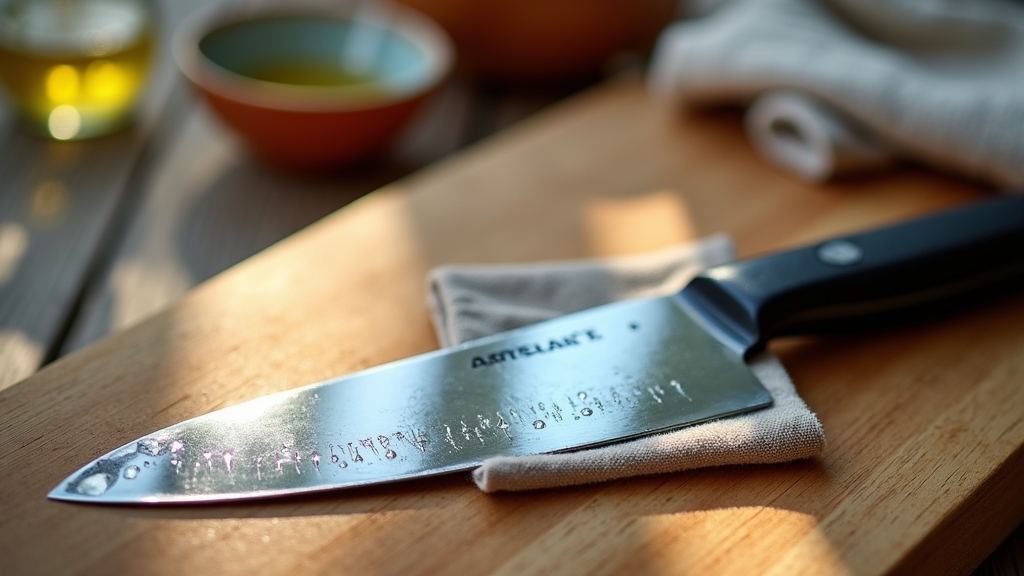
You know, it’s really important to encourage that patina to form on your carbon steel knives. Not only does it look nice, but it also creates a protective oxide layer that helps minimize rust development. Forcing a patina can significantly help protect carbon steel blades from rust.
Just keep in mind to avoid exposing the blade to acids; they can really mess with that layer and speed up corrosion. Proper cleaning and drying after use is essential to prevent moisture buildup that accelerates rust.
After you clean your knife, a great tip is to consistently apply a thin coat of food-grade oil. This little step goes a long way in inhibiting oxidation and keeping your blade in tip-top shape.
Patina Formation Benefits
When you regularly use and care for carbon steel knives, a protective patina naturally develops, enhancing the blade’s resistance to rust and corrosion.
This controlled oxidation layer forms iron oxide compounds that shield the steel from further deterioration, extending the knife’s lifespan markedly.
Patina not only prevents rust but also stabilizes discoloration, reducing maintenance demands.
It creates a unique surface pattern that’s both functional and aesthetic, personalizing your blade.
Consider these patina formation benefits:
- Increases corrosion resistance up to 4–5 times compared to bare steel
- Acts as a self-renewing protective seal against moisture and acids
- Balances the vulnerability of high carbon content in steel
- Enhances blade longevity and consistent cutting performance
- Provides individualized visual character reflecting usage and environment
A mature patina develops through stages, progressing from golden yellow to deep blue and finally to a stable gray or blue-black, which signifies enhanced oxidation depth and protection.
Regular maintenance, including cleaning and sharpening, is essential to support patina formation and maintain optimal cutting performance.
Acid Exposure Avoidance
How quickly you address acid exposure on carbon steel knives considerably impacts their susceptibility to rust and corrosion.
Immediately rinse the blade under lukewarm or cold running water after contact with acidic foods like lemons, tomatoes, or vinegar.
Hot water accelerates corrosion, so avoid it. Remove all residues thoroughly, as even trace amounts can initiate rust. Using proper cleaning techniques helps protect the blade’s sharpness and integrity.
Pat the blade dry with a paper towel promptly; air-drying or cloth towels risk retaining moisture.
Limit prolonged contact with acids by reserving carbon steel knives for non-acidic tasks. Remember to wear proper protective gear when handling any acidic substances to prevent accidental damage or injury.
Prolonged exposure microscopically erodes edges and dulls sharpness.
Store knives dry in ventilated areas, avoiding humid environments and wood blocks that trap moisture.
Regularly inspect blades for early rust signs and act immediately to prevent progression, ensuring your carbon steel knives maintain ideal longevity and performance.
Consistent Oil Application
Following thorough cleaning and immediate drying after acid exposure, applying a protective layer of oil considerably reduces the risk of rust on carbon steel knives.
You should select food-grade, non-reactive oils such as Tsubaki, camellia, or specialized blade oils to avoid contamination.
Applying a thin, even coat using a tissue or cloth ensures extensive coverage without excess residue. Consistent application after every cleaning creates an effective moisture barrier, critical for preventing oxidation. This practice aligns with MUSASHI’s dedication to Craftsmanship & Legacy, emphasizing the preservation of traditional knife care.
Additionally, maintaining a clean and dry storage environment with proper storage solutions significantly supports the longevity of the oil’s protective effect.
Store your oiled knives in dry environments to maintain this protective layer and inhibit rust formation.
- Use food-safe, non-reactive oils
- Apply oil after each cleaning and drying
- Use cloth or tissue for thin, even coverage
- Store knives in dry, moisture-free conditions
- Inspect regularly to maintain oil layer integrity
Creating and Maintaining a Protective Patina
Although patina naturally forms over time through oxidation, you can actively create and maintain this protective layer to enhance your knife’s durability and corrosion resistance.
Patina develops as iron oxide compounds form on carbon steel surfaces when exposed to air, moisture, and acids, producing a barrier against further rust. This natural oxidation layer not only protects the blade but also adds unique character and aesthetic appeal.
Patina forms on carbon steel through iron oxide layers that protect against rust and corrosion.
You can accelerate patina formation by applying acidic substances like mustard or vinegar, carefully controlling contact time and acidity to achieve desired colors and protection without inducing rust.
To maintain the patina, clean the blade promptly with water and dry thoroughly, then seal it with oils such as camellia or mineral oil.
Avoid prolonged moisture exposure and wipe fingerprints to prevent localized corrosion. Properly maintained, patina preserves blade integrity and sharpness while providing a unique aesthetic.
Using Common Household Items to Prevent Rust
When you want to prevent rust on your knives without specialized products, several common household items offer effective solutions.
Baking soda creates a gentle abrasive paste that removes light rust without scratching. Acidic agents like white vinegar and lemon juice dissolve rust oxides but require short exposure to avoid blade etching. Since rust forms when steel is exposed to moisture and oxygen over time, limiting this exposure is key.
Applying food-safe oils forms a moisture barrier, which is essential after cleaning or acidic treatment. Proper drying and storage further inhibit rust by eliminating moisture exposure.
Baking soda paste combined with mild scrubbing. Short vinegar or lemon juice soaks for rust dissolution. Food-grade oil application to block moisture.
Thorough drying with cloth or paper towels. Storing knives in dry, ventilated holders away from dampness.
These methods maintain blade integrity by targeting moisture and corrosion precursors effectively.
Recognizing and Addressing Early Signs of Rust
How can you detect rust before it compromises your knife’s performance?
Start by inspecting the blade for small reddish-brown spots or discoloration, especially near the handle and cutting edge.
Inspect the blade carefully for tiny reddish-brown spots and discoloration near the handle and cutting edge.
Feel for rough or uneven textures that indicate early corrosion beneath the surface.
Be alert to any metallic odor, which often precedes visible rust.
Frequent exposure to moisture, salt, acidic foods, or mechanical damage increases rust risk.
When rust appears, you can try using a baking soda paste as a gentle cleaning method to remove it effectively.
Upon detecting early rust, immediately clean the blade with mild detergent and dry it thoroughly.
Use a non-abrasive pad or rust eraser for light surface rust, then apply a thin layer of food-safe mineral oil to create a moisture barrier.
For deeper pitting rust, seek professional restoration to prevent structural damage and maintain blade integrity.
Frequently Asked Questions
Can Rusted Knives Be Safely Used for Food Preparation?
You shouldn’t use rusted knives for food preparation.
Rust compromises blade integrity, sharpness, and cleanliness, increasing contamination and injury risks. Rust particles can transfer to food, potentially harboring bacteria beneath the surface.
Even if small rust amounts seem harmless, repeated exposure can pose health hazards. Always remove rust thoroughly and confirm the blade is clean and structurally sound before use.
Prioritize safety and hygiene over convenience when handling rusted knives.
Does Rust on Knives Affect the Taste of Food?
Yes, rust on knives can affect the taste of food. When you cut with a rusted blade, iron oxide particles may transfer to your food, causing a metallic flavor that’s unpleasant.
This contamination can alter the food’s palatability, especially in acidic or moisture-rich ingredients. Additionally, rust can introduce off-flavors and discoloration, degrading overall quality.
To preserve taste, you should avoid using rusted knives and guarantee blades remain rust-free.
Are Electric Knife Sharpeners Safe for Carbon Steel Blades?
Yes, electric knife sharpeners can be safe for carbon steel blades if you use modern models with 100% diamond abrasives and precise angle guides.
You shouldn’t use older or basic sharpeners that risk overheating and excessive metal removal.
Maintain the correct sharpening angle and apply minimal pressure to avoid edge damage.
Choose sharpeners designed for carbon steel and follow manufacturer guidelines carefully to preserve edge retention and blade durability.
How Often Should Knives Be Replaced Due to Rust?
Think of rust as a silent thief stealing your knife’s strength. You should replace knives once rust causes deep pitting, irreversible spots, or blade edge damage.
For high-quality steels, this might take years, but lower-grade knives may need replacement within months.
Regular maintenance delays this, yet visible corrosion, chipping, or compromised cutting performance demands immediate replacement to maintain safety and efficiency in your tasks.
Can Rust Spread From Knives to Other Kitchen Utensils?
Yes, rust can spread from knives to other kitchen utensils through direct contact and moisture transfer.
If you store rusty knives alongside other metal tools in humid conditions, oxidation accelerates, contaminating nearby utensils.
To prevent this, you should separate your knives, keep all utensils dry, and regularly inspect and clean them.
Using protective coatings and high-quality materials further minimizes rust propagation within your kitchen environment.
Next Step: Build a Rust-Proof Knife Care Routine
By consistently cleaning and drying your knives like clockwork, you’ll keep rust at bay with precision.
Applying protective coatings and storing knives properly creates a barrier as reliable as a fortress wall.
Address rust early using effective removal methods to prevent damage from spreading.
For carbon steel knives, maintaining a patina is essential.
With these analytical steps, your knives will stay sharp and rust-free, ensuring ideal performance every time you use them.



